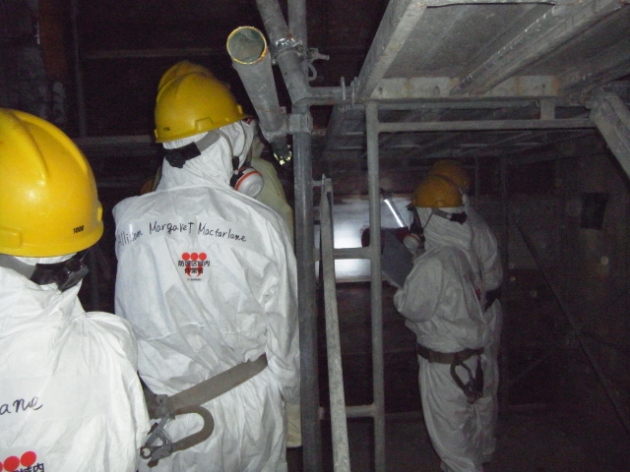Dateline: FUKUSHIMA NUCLEAR COMPLEX
Posted by on December 13, 2012

NRC
Chairman Allison Macfarlane and other NRC officials in the darkened
interior of Reactor 4 at the Fukushima Dai-ichi nuclear complex
northeast of Tokyo Dec. 13.
Macfarlane, who is leading a delegation of high-ranking U.S. officials to a meeting in Japan on improving nuclear safety, toured the stricken complex and praised assembled employees “for the creative and selfless actions” during and after the crisis. “You are true heroes,” she said.
The tour of the facility helped offer a “sense of what you went through” and “what you learned. All regulators need to learn these lessons,” she added.
Macfarlane was accompanied by several senior NRC officials on the site visit, along with U.S. Embassy officers and others. All donned layers of protective clothing and full-face respirators – the same as worn by plant cleanup workers – for the tour of the facility.
Stepping into an industrial elevator for the four-floor ride to the top of the spent fuel pool at reactor 4, heavily damaged by one of several hydrogen explosions to rip through the complex, the visitors stood by the thick steel plates covering the pool. They then descended narrow stairs to view work undertaken by TEPCO to provided added strength to the pool structure.
Reached by a three-hour train and bus journey from Tokyo, the NRC team approached the site through empty villages in which weeds grew in vacant parking lots in front of storefronts with broken windows and interiors littered with debris. The visit came on one of the rare days displaced residents were allowed back to their homes.
The U.S. Delegation will meet with leaders of the new Japanese nuclear regulatory counterpart to the NRC on Friday, then take part in the gathering of global nuclear regulatory officials in Koriyama City over the weekend.
Here is the text of a statement issued by Macfarlane after her Fukushima tour:
Today’s visit to the Fukushima Dai-ichi nuclear power plant, nearly two years after the devastating earthquake and tsunami that caused the nuclear accident, was a deeply moving and thought-provoking experience. We commend the people of Japan for their courage in working to mitigate the effects of the accident in the face of tremendous obstacles at great personal risk, especially in the first few weeks after the disaster.
There are a number of lessons that have come from this tragic accident that are important for all countries with nuclear power reactors including: the importance of an independent regulator that operates in an open and transparent manner; the need for measures to prevent and mitigate severe accidents that displace people or contaminate land; and the significance of international cooperation to share experience and expertise to strengthen nuclear safety and security worldwide.
The accident has profoundly changed the nuclear safety landscape and brought a new urgency to improving nuclear safety worldwide. We’ve learned a considerable amount from the accident, identified numerous specific technical issues that require renewed attention, and made measurable progress in implementing improvements. But there is more work ahead and we are committed to working with Japan and other international partners to ensure long-term sustainability in the nuclear safety enhancements made since the accident.
Eliot Brenner Director, Office of Public Affairs

No comments:
Post a Comment